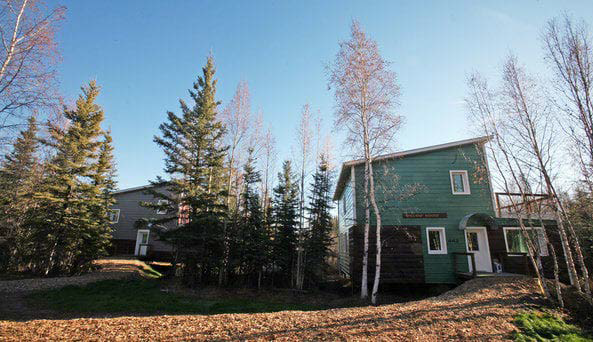AkDU'S AND DON'TS
Download the BookA Practical Approach to Bringing Additional Dwelling Units to Alaska Communities
What is an Accessory Dwelling Unit (ADU)?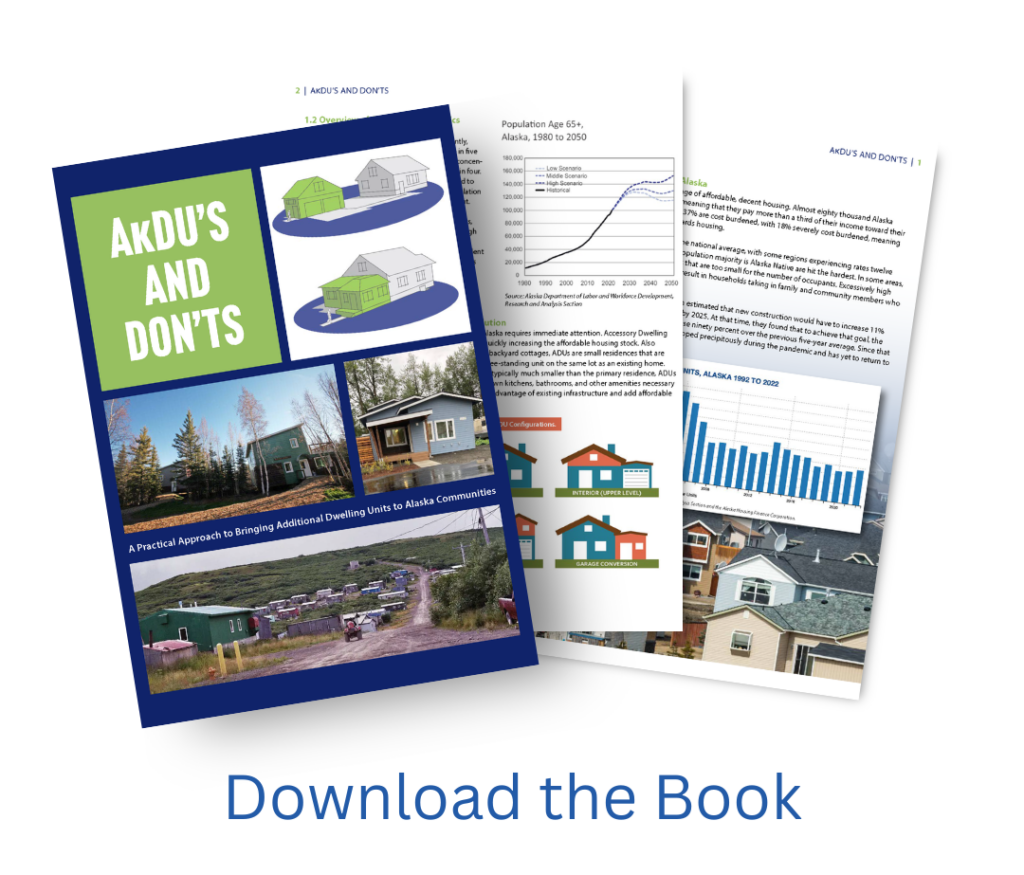
ADUs are independent housing units attached to an existing residence or constructed on the same lot. Also known as “granny flats,” “backyard cottages,” and “mother-in-law apartments,” ADUs have kitchens, bathrooms, and bedrooms entirely separate from the primary residence.
ADU Benefits:
For Communities Generally:
- Low-cost method to expand access to affordable and accessible housing in your community.
- Encouraging the construction of ADUs that meet the accessibility needs of aging Alaskans expands the accessibility of a community’s housing stock in the long run, dramatically increasing inclusivity.
- Increases density in areas where city services already exist.
- Can provide homeowners with additional income.
- Increases home values, increasing home equity for homeowners and growing property tax revenues for municipalities.
- Facilitates multi-generational living, which strengthens community and cultural connections, prevents de-population, and fights “brain-drain.”
- ADUs can be built to meet the needs of aging family members and then later serve the next generation returning home after completing their education.
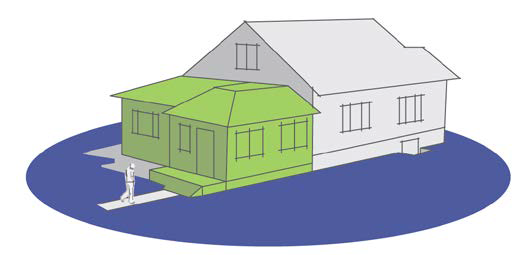
For Aging Alaskans in Particular:
- Adding an ADU to the home of an elderly individual or that of their adult children can provide proximity to caregivers, facilitating aging at home.
- ADUs can be intentionally constructed to meet the specific accessibility needs of elderly Alaskans, allowing them to maintain their independence and remain within their community.
- ADUs can be used to generate income to cover property taxes and maintenance during retirement.
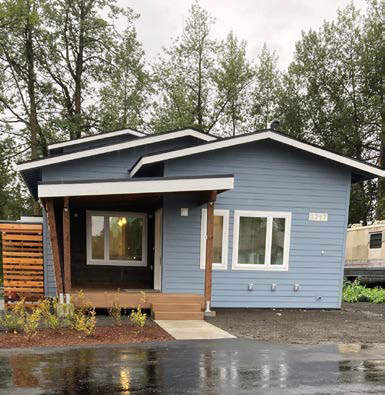
Takeaways for Municipal Officials:
For Communities with Existing Zoning Regulations:
A recommended first step for local officials interested in increasing ADU development is the creation of a dedicated ADU ordinance. This clarifies the ADU development process for applicants and municipal officials and removes barriers that may have been hindering development under existing general zoning regulations.
Simply altering existing zoning regulations to allow ADUs without providing specific regulations and guidance may not be enough to meaningfully encourage development. Though experts consider designated construction of an accessory dwelling unit as a permitted use for all single-family residences as the gold standard for encouraging ADU development, doing this alone can leave interested homeowners feeling confused or uncertain. Additionally, such opaque regulations can allow development that those who are resistant to increased density find upsetting or inflammatory, prompting pushback and calls for increased restrictions. ADU-specific regulations can avert such backlash.
This publication go into considerable detail about the policies experts across the nation have found are most effective to encouraging ADU development.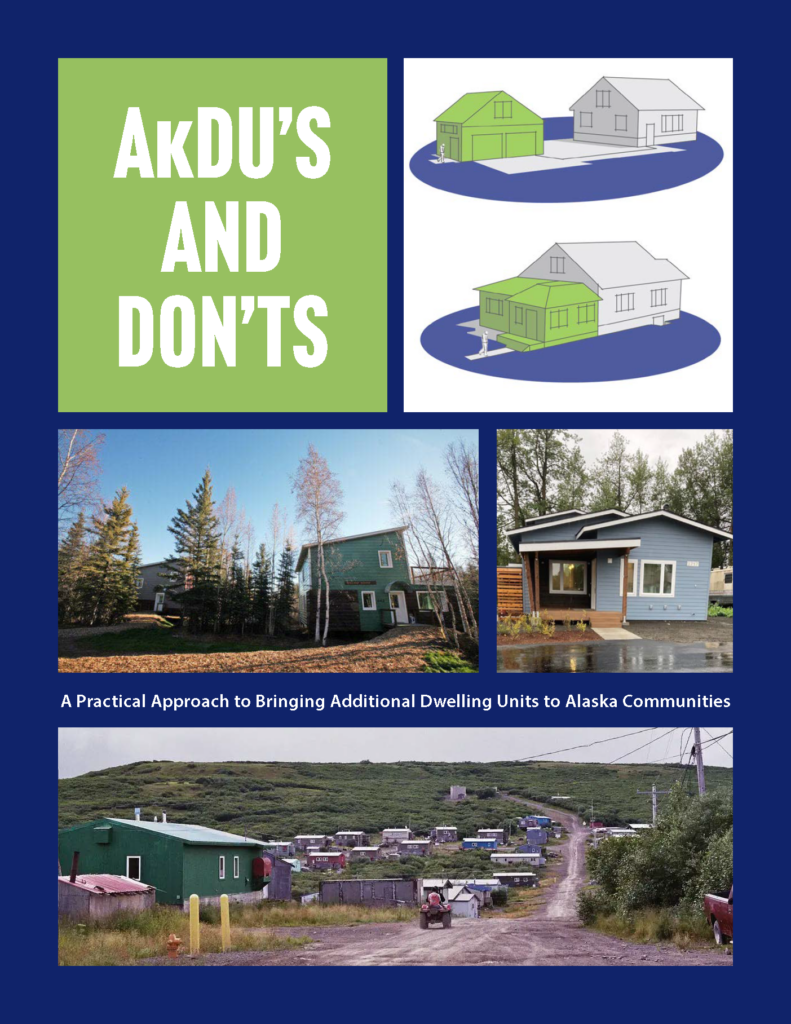
Below is a brief overview:
Encouraging ADU Development: Do’s
- Allow ADU development “by-right” rather than through a discretionary approval process.
- Municipalities often still require all homeowners to submit an application to the city for ministerial approval.
- Experts suggest, at minimum, extending blanket use permissions for ADUs in all areas zoned for residential use, but many communities have found success including commercial or mixed-use districts as well.
- For communities that have a lot of variation within zoning districts, such as nonuniform lot sizes and varied access to city sewage/water/electricity, it might be helpful to construct a “split” process. ADUs that comply with all regulations are allowed “by-right,” but applicants who do not meet the requirements must apply for exceptions through a conditional permitting process.
- Set a realistic timeline for producing decisions.
- Outline clear, objective standards intended to mitigate environmental hazards and impact on city resources. Regulations should reflect community values without hindering development.
- Create reasonable size/height/setback requirements that ensure the resulting unit can meet the needs of long-term rentals and aging individuals.
- Reduce financial barriers where possible. Providing financial incentives for certain purposes, such as for those who commit to renting their ADU on a long-term basis or intend to use it for a family member, can encourage ADU development for specific uses without applying a blanket policy to all homeowners.
- Communities interested in investing a lot of money and resources into this effort can develop a designated municipal funding scheme that subsidies ADU development through grants or low-interest loans.
- Communities with fewer resources to dedicate to this can reduce financial barriers by creating a selection of pre-approved, permit ready plans for interested applicants to choose from, waiving permitting and/or inspection fees, or providing property tax abatement.
Encouraging ADU Development: Don’ts
- Subject all ADUs to a discretionary permitting process. Conditional approval procedures create uncertainty and slow development.
- Impose excessive size/height/setback restrictions. These inhibit development in dense areas with smaller lots where demand for rentals is likely higher and can lead to “micro” units that can make it difficult to ensure bathrooms and living spaces are of adequate size to accommodate accessibility devices such as wheelchairs or allow caregiver support.
- Require additional off-street parking spaces.
- Regulate exterior aesthetics.
- Force homeowners with ADUs on their property to live in the primary residence in order to rent out the ADU.
While it is best to adhere to these recommendations whenever possible, keeping political viability in mind is also important. If you are looking for support with weighing community concerns against best practices, have any other questions about getting started, or want help addressing any other housing issues in your community, please reach out to AML’s Housing Fellow Abby Barton.
For Communities without Zoning Regulations
Creating an ADU-specific ordinance and/or focusing on reducing regulatory barriers is not the most effective approach for encouraging ADU development in communities that have no zoning regulations. Most likely, your largest barriers to ADU construction are the same as that for all housing: excessive costs relating to materials, shipping, and construction. Though there are parts of AML’s ADU publication that may still be of use to your community, such as the resources on accessible design practices, prefabricated units, and facilitating economies of scale to reduce costs, we acknowledge that this resource does not truly meet your needs. AML is committed to supporting the housing needs of our rural members, so please reach out to our Housing Fellow, Abby Barton, abigailb@akml.org, to schedule a time to discuss how we can best assist your community.
AkDU’S AND DON’TS
This publication was authored by Abigail Barton, a member of the Alaska Fellows Program, and Alicia Hughes-Skandijs. It was made possible through generous support provided by the AARP Community Challenge Grant. The AARP Community Challenge Grant is part of a nationwide livable communities initiative to help communities become great places to live for residents of all ages.



